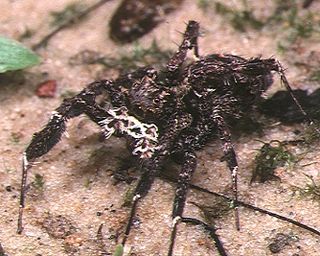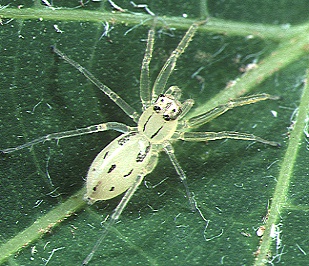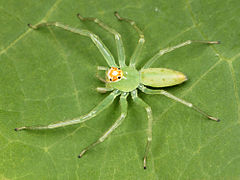
Jumping spiders are a group of spiders that constitute the family Salticidae. As of 2019, this family contained over 600 described genera and over 6,000 described species, making it the largest family of spiders at 13% of all species. Jumping spiders have some of the best vision among arthropods and use it in courtship, hunting, and navigation. Although they normally move unobtrusively and fairly slowly, most species are capable of very agile jumps, notably when hunting, but sometimes in response to sudden threats or crossing long gaps. Both their book lungs and tracheal system are well-developed, and they use both systems. Jumping spiders are generally recognized by their eye pattern. All jumping spiders have four pairs of eyes, with the anterior median pair being particularly large.

Phidippus audax, the bold jumper or bold jumping spider, is a common species of spider belonging to the genus Phidippus, a group of jumping spiders easily identified by their large eyes and their iridescent chelicerae. Like all jumping spiders, they have excellent stereoscopic vision that aids them in stalking prey and facilitates visual communication with potential mates during courting. Bold jumping spiders are native to North America and have been introduced to Hawaii, Nicobar Islands, Azores, and the Netherlands. They are typically black with a distinct white triangle on their abdomen.

Ascyltus are a genus of jumping spiders in the family Salticidae that was first described by Ferdinand Anton Franz Karsch in 1878. As of December 2020, the genus contained 10 species. Ascyltus spiders utilize their vision in courtship, hunting, and navigation. They are typically large to medium-sized salticids and often move relatively slowly. However, they are capable of agile jumps when moving, hunting, or to avoid predators. They have well developed book lungs and tracheal systems, and they are capable of utilizing both systems. Ascyltus have four pairs of eyes, with the anterior median pair being the most prominent. One distinguishable characteristic of the genus is their antero-lateral carapace, which is iridescently coloured.
Hindumanes is a genus of jumping spiders found in India. The name Hindumanes is a portmanteau of "Hindu", the dominant religion of India, and Lyssomanes, the genus H. karnatakaensis was initially assigned to. As of August 2023, two species have been described:

Lyssomanes is a spider genus of the family Salticidae, ranging from South and Central America, up to the southern United States.

Lyssomaninae is a subfamily of jumping spiders. It includes four genera, three from the New World.

Portia fimbriata, sometimes called the fringed jumping spider, is a jumping spider found in Australia and Southeast Asia. Adult females have bodies 6.8 to 10.5 millimetres long, while those of adult males are 5.2 to 6.5 millimetres long. Both sexes have a generally dark brown carapace, reddish brown chelicerae ("fangs"), a brown underside, dark brown palps with white hairs, and dark brown abdomens with white spots on the upper side. Both sexes have fine, faint markings and soft fringes of hair, and the legs are spindly and fringed. However, specimens from New Guinea and Indonesia have orange-brown carapaces and yellowish abdomens. In all species of the genus Portia, the abdomen distends when the spider is well fed or producing eggs.

Asemonea virgea is a species of jumping spider in the genus Asemonea that is endemic to the Republic of the Congo. The spider was first described in 2003 by Wanda Wesołowska and Tamás Szűts. The spider is small, with a dark yellow carapace typically 1.6 mm (0.063 in) long and an abdomen 1.8 mm (0.071 in) long. The male has a distinctive set of spines on its palpal tibia, after which it is named. It is similar to the related Asemonea cristata but differs in its species range, as the other spider is found in Burma, and its shorter femoral apophysis. The female has not been described.

Asemonea cuprea is a species of jumping spider in the genus Asemonea that is found in South Africa and Zambia. The spider was first defined in 2009 by Wanda Wesołowska, one of over 500 that the arachnologist described during her career. It is small, generally yellow and lives on the leaves of short shrubs. It has an pear-shaped carapace and a narrower abdomen that each have a length between 1.5 and 1.7 mm. The male has a distinctive coloration with bright orange scales covering the clypeus and eye field and vivid orange hairs on the back half of the abdomen, which are recalled by the species name. The male also has an unusual right-angle shaped subtegulum and the female a simpler epigyne than other Asemonea species that helps identify the species.

Asemonea pallida is a species of jumping spider in the genus Asemonea that is endemic to Kenya. The spider was first defined in 2001 by Wanda Wesołowska, one of over 500 that the arachnologist described during her career. The spider is small, and light, nearly white, as is reflected in the species name. It has an elongated carapace that is between 1.9 and 2.2 mm long and a broader abdomen that has a length between 3.0 and 3.1 mm. The female has a distinctive epigyne with two depressions joined by an elevated bridge. The male has not been described.

Asemonea clara is a species of jumping spider in the genus Asemonea that is endemic to South Africa. The spider was first defined in 2013 by Wanda Wesołowska and Charles Haddad. The spider is small, with a cephalothorax that is between 1.9 and 2.2 mm long and an abdomen that is between 2.2 and 2.4 mm long. The white carapace is pear-shaped and the abdomen is white apart from two dark lines across the front, a small round dot in the middle and a black dot towards the back. The male has not been described.

Eris militaris, known commonly as the bronze jumper or bronze lake jumper, is a species of jumping spider, belonging to the Salticidae family. It is found in the United States and Canada within both suburban and rural areas. The male and female of this species can be differentiated from their size or by the coloration on their cephalothorax and abdomen. The females have a lighter cephalothorax a slightly darker abdomen with white spots. They are active in the autumn and winter season and can be found in sheltered areas within vegetation. They can also be found living within apple orchards, where insecticides may be present, which can potentially effect or alter their personality and behavior. Their diet consists of small insects, almost anything they can hold.

Asemonea tanikawai is a species of jumping spider in the genus Asemonea that is endemic to Japan. It lives in trees in mountain ranges. The spider was first described in 1996 by Hiroyoshi Ikeda. The spider is small, with a carapace [prosoma that between 1.31 and 1.60 mm long and an abdomen is between 1.84 and 2.24 mm long. It is whitish-yellow with a pattern of two brown stripes down the back of the carapace and nine black dots on the back of the abdomen. The male has a distinctive pedipalp with a complex tibial apophysis and a furrow alongside the femoral apophysis, which distinguishes it from the otherwise similar Asemonea maculata and Asemonea pinangensis. The female is also similar, with its copulatory openings hidden in its epigyne. The spider has been found throughout Okinawa and the other Ryukyu Islands.

Asemonea pinangensis is a species of jumping spider in the genus Asemonea that is endemic to Malaysia. The spider was first defined in 1980 by Fred Wanless. It is a small spider, with a carapace that is typically 1.16 mm (0.046 in) long and an abdomen typically 1.2 mm (0.047 in) long. The carapace is whitish-yellow with black markings and the abdomen black with whitish-yellow markings. The coloration, as well as the lip on its dorsal tibial apophysis, help distinguish the species from the otherwise similar Asemonea maculata, Asemonea minuta and Asemonea tanikawai. The female has not been described.

Asemonea maculata is a species of jumping spider in the genus Asemonea that is endemic to Ivory Coast. The spider was first defined in 1980 by Fred Wanless. It is a small spider, with a carapace that is between 2.08 and 2.10 mm long and an abdomen typically 2.4 mm long. The carapace is amber to whitish-yellow and the abdomen whitish-yellow, both with black markings. It is similar to the related species Asemonea pinangensis and Asemonea tanikawai, but can be distinguished by the tibia on the male pedipalp. The female has not been described.

Asemoneinae is a subfamily of jumping spiders. It was created in 2015 by Wayne Maddison. Most species are found in Africa or Asia. The subfamily initially had five genera, but Hindumanes was later transferred to the subfamily Lyssomaninae.

Cosmophasis lami, also known as the Lami Beach northern jumping spider or tangerine garden jumper, is a species of jumping spider in the genus Cosmophasis, probably native to South East Asia and some pacific islands, and possibly introduced to Japan and Okinawa Islands by humans. It was first described by Berry, Beatty & Prószynski in 1997 and has one synonym, Cosmophasis squamata (Saaristo,2002) Both the female and the male have been described.

Asemonea murphyae is a species of jumping spider in the genus Asemonea that lives in Kenya and South Africa. First defined in 1980 by Fred Wanless, the spider is named after the British arachnologist Frances M. Murphy. Asemonea murphyae thrives in a wide range of environments, particularly by the side of rivers, streams and tracks. A small spider, with a carapace that is between 1.48 and 2.00 mm long and an abdomen between 2.4 mm long, it is generally yellow with a green tint that enables it to blend into its environment. The female is smaller than the male. The species can be distinguished from other spiders in the same genus by the design of the female's epigyne and the male pedipalp, particularly the male's forked spike on the palpal tibia.

Asemonea stella is a species of jumping spider in the genus Asemonea that lives in Kenya, South Africa and Tanzania, and has been introduced to Australia. It thrives in a wide range of environments, from open farmland to semi-aquatic vegetation. The spider was first defined in 1980 by Fred Wanless. The spider is small, between 3.1 and 3.64 mm long, the female being generally larger than the male. It has a carapace that is pear-shaped and either yellow in the case of the male or green in the case of the female, measuring between 1.28 and 1.46 mm in length.The abdomen is whiter, between 1.28 and 1.46 mm long and has a distinctive star-shaped pattern on the back. Its copulatory organs help differentiate the species, particularly the furrow on the femoral apophysis of the male palpal bulb and the shallow depression in the middle of the female epigyne.

Maevia intermedia is one of eight species of Salticidae, or jumping spider, in the genus Maevia, and is native to North America. This species was originally reported by American Zoologist Robert D. Barnes in 1955 as a needed distinguishment between the similar-looking Maevia species, especially those found in the Americas.




















